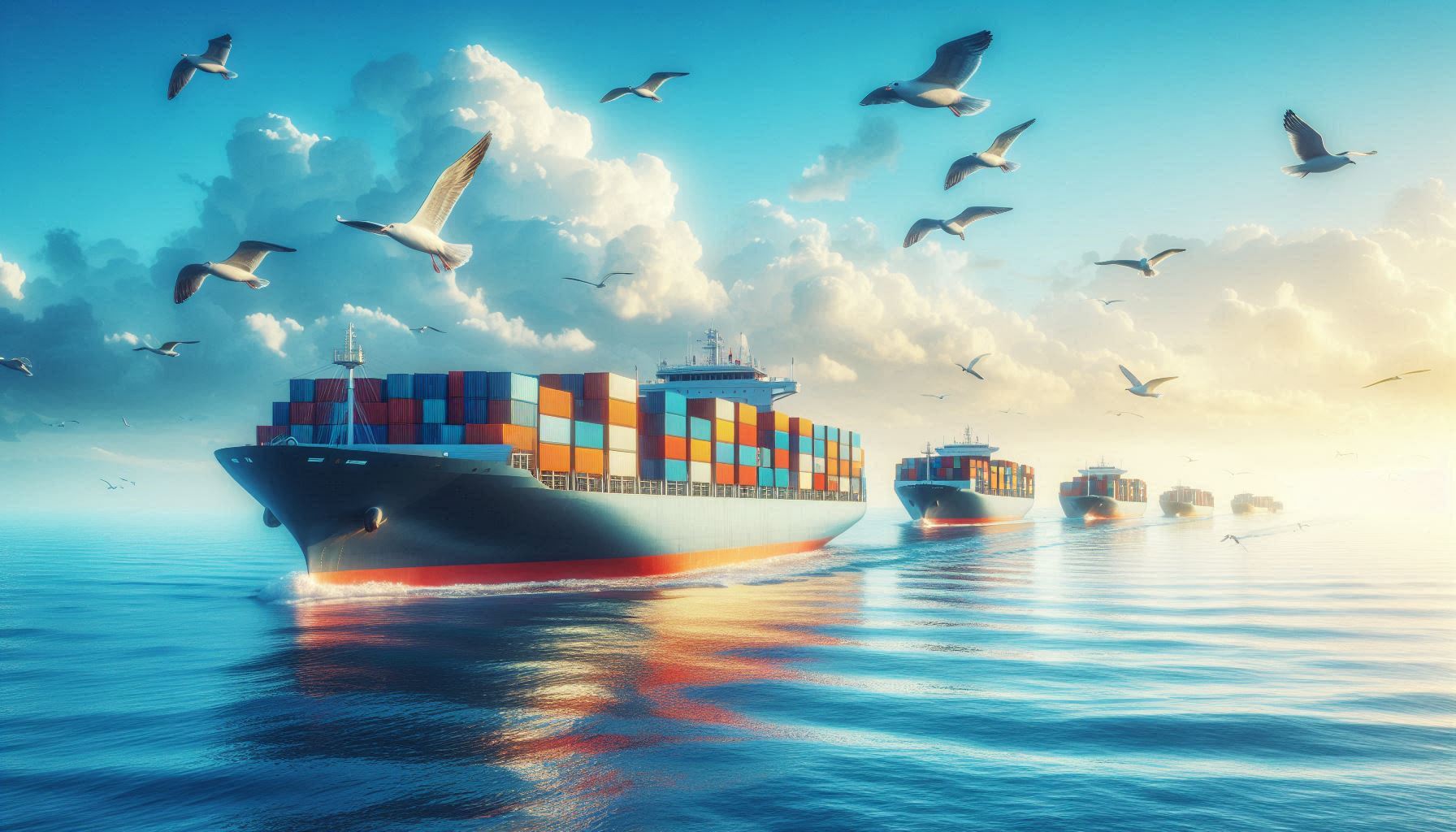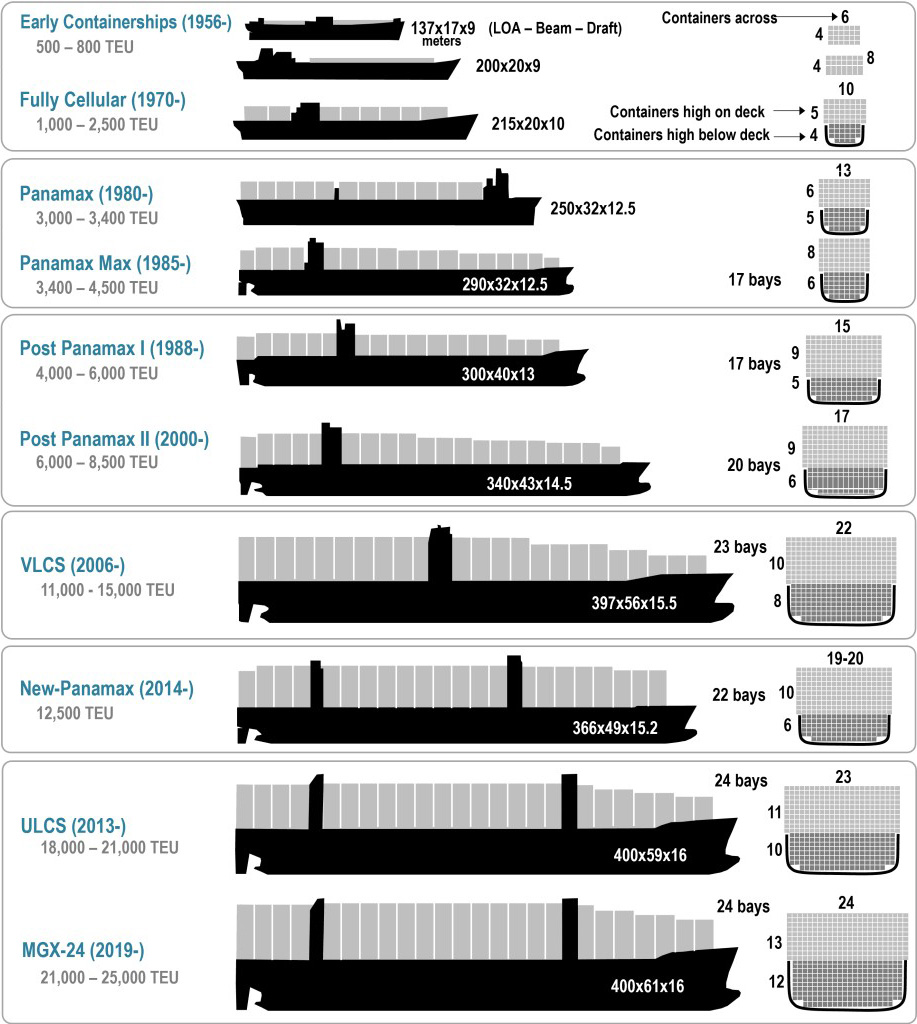Container ships play a crucial role in international trade, serving as one of the main modes of transportation for cargo and goods. Due to their specific design, which allows for the transportation of containers, these ships have revolutionized the maritime transport industry. This article examines the different types of container ships, including Feeder ships, Feeder Max ships, Panamax ships, Post-Panamax ships, Suezmax ships, Post-Suezmax ships, Post-Malaccamax ships, and Ultra Large Container Ships (ULCS). It also discusses the applications, advantages, and limitations of each type of container ship in maritime transport.
Classification of Container Ships:
Feeder Ships
Feeder ships are smaller container vessels that act as intermediaries between large and small ports. These ships typically have lower capacity and are used to transport containers to local ports or ports that cannot accommodate larger vessels. They are designed specifically to meet local and regional transport needs, playing an important role in maritime transport networks.
Applications:
Feeder ships are primarily used to transport containers between main ports and smaller ones. They are usually active in local and regional transport networks, transporting cargo loaded at major ports to their final destinations. These ships are ideal for providing regular services and creating a connected transportation network between ports. In addition to transporting containers, they are also used for bulk cargo transportation.
Advantages:
Access: Feeder ships can access smaller and more remote ports that larger ships cannot reach.
Lower Costs: Due to their smaller size, operational costs are typically lower than those of larger vessels.
Flexibility: Feeder ships can move quickly and regularly between ports, facilitating the movement of goods.
Connection with Mega-ships: These ships can connect with larger mega-ships and access low-draft ports, which is an added advantage.
Limitations:
Lower Capacity: Feeder ships have less cargo capacity due to their smaller size.
Longer Travel Time: These vessels may take longer to transport goods as they often visit multiple ports in one trip.
Higher Unit Costs: The cost per container transported may be higher due to the smaller capacity.
Container Capacity:
Feeder ships can usually carry between 500 to 1200 TEUs.

Feeder Max Ships
Feeder Max ships are a larger version of the Feeder ships, offering higher capacity and access to larger ports.
Applications:
These ships are used to transport goods between major and medium-sized ports, capable of carrying more containers than regular feeder ships.
Advantages:
Higher Capacity: Feeder Max ships can carry more containers than standard feeder ships.
Increased Flexibility: They can access more diverse routes and reach more ports.
Limitations:
Higher Operational Costs: Larger size leads to higher operational costs.
Need for Better Infrastructure: The destination ports must be capable of accommodating larger ships.
Container Capacity:
Feeder Max ships can usually carry between 1200 to 2000 TEUs.
Panamax Ships
Panamax ships are designed to pass through the Panama Canal. These container vessels typically range from 240 to 250 meters in length and 32 meters in width, with a maximum capacity of about 5000 TEUs.
Applications:
These ships are commonly used for international transport, including consumer goods, raw materials, and semi-finished products. Due to their optimal size and ability to pass through the Panama Canal, they are popular for trade between the eastern and western coasts of the United States and between Asia and Europe. They are also used in the transport of oil, gas, and bulk commodities.
Advantages:
Higher Capacity: Panamax ships offer a higher capacity compared to feeder vessels.
Can Pass Through the Panama Canal: This reduces transit time and shipping costs.
Higher Efficiency: Suitable speed and optimized design.
Limitations:
Dimensional Restrictions: They may not pass through all ports or maritime routes.
Higher Costs: Operational costs and fuel consumption are higher.
Container Capacity:
Panamax ships can typically carry between 5000 to 6000 TEUs.
Post-Panamax Ships
Post-Panamax ships are larger than Panamax vessels and cannot pass through the Panama Canal but offer higher capacity and performance.
Applications:
These ships are used for international transport, offering greater capacity on longer routes, primarily from Asia to Europe and America.
Advantages:
Very High Capacity: Can carry a large number of containers.
Increased Productivity: Reduces the cost per unit of transport.
Limitations:
Need for Larger Ports: Access is limited to specific ports.
Higher Operational Costs: Increased fuel and maintenance needs.
Container Capacity:
Post-Panamax ships can usually carry between 6000 to 8000 TEUs.
Suezmax Ships
Suezmax ships are container vessels that are designed to pass through the Suez Canal. These ships typically range from 200 to 230 meters in length and 32 meters in width.
Applications:
Used on routes passing through the Suez Canal, particularly for the transport of oil and gas.
Advantages:
Ability to Pass Through the Suez Canal: Provides access to critical trade routes.
Balanced Size and Capacity: Suitable for transporting a reasonable volume of cargo.
Limitations:
Geographical Restrictions: Limited to Suez Canal routes.
Higher Costs: Requires specific infrastructure and higher maintenance.
Container Capacity:
Suezmax ships can usually carry between 8000 to 10,000 TEUs.
Post-Suezmax Ships
Post-Suezmax ships are larger than Suezmax vessels and offer higher capacity but cannot pass through the Suez Canal.
Applications:
Used for high-capacity international transport on long and commercial routes.
Advantages:
Very High Capacity: Can carry a large volume of containers.
Increased Efficiency: Reduces the cost per unit of transport.
Limitations:
Need for Larger Ports: Limited to specific ports with the necessary infrastructure.
Higher Operational Costs: Requires more fuel and maintenance.
Container Capacity:
Post-Suezmax ships can typically carry between 10,000 to 12,000 TEUs.
Post-Malaccamax Ships
Post-Malaccamax ships are larger than Malaccamax vessels and offer higher capacity but cannot pass through the Malacca Strait.
Applications:
Used for international transport on long, commercial routes with very high capacity.
Advantages:
Extraordinary Capacity: Can carry a massive amount of containers.
Increased Efficiency: Reduces the unit cost of transport due to the high capacity.
Limitations:
Need for Extremely Large Ports: Limited access to certain ports.
Very High Operational Costs: Requires substantial fuel and maintenance.
Container Capacity:
Post-Malaccamax ships can carry between 15,000 to 20,000 TEUs.
Ultra Large Container Ships (ULCS)
ULCS are the largest container vessels in the world, typically measuring over 300 meters in length and over 42 meters in width, with a capacity of over 20,000 TEUs.
Applications:
Used for international transport on long commercial routes, especially between Asia, Europe, and America.
Advantages:
Extremely High Capacity: Can carry a very large number of containers in one trip.
Optimized Costs: Reduces transportation costs per container.
High Efficiency: Suitable speed and design for long-haul routes.
Limitations:
Geographical Restrictions: Limited access to ports with suitable infrastructure.
Very High Operational Costs: Requires significant fuel and maintenance.
Need for Advanced Infrastructure: Ports must be equipped with the latest technology to handle these vessels.
Container Capacity:
ULCS can typically carry more than 20,000 TEUs.
Conclusion
Container ships come in various types, each with different capacities, sizes, and designs tailored for specific uses in maritime transport. From small feeder ships to Ultra Large Container Ships, each type has its own advantages and limitations. Companies like Versk in the shipping and transportation sector can guide the selection of the most suitable container ship for efficient cargo handling, facilitating international trade.
Versk Shipping and Transport Company
Versk offers comprehensive services in the shipping and transport sector and is recognized as a reliable partner in international trade. Our services include chartering, slotting, transport consulting, container ship services, and other shipping services. We leverage our expertise to provide the best solutions for your transportation needs, ensuring safe, fast, and optimized cargo handling.
Destinations Served
Versk operates extensively in the following destinations:
Mundra (Mundra, India 🇮🇳)
Navi Mumbai (Navi Mumbai, India 🇮🇳)
Chennai (Chennai, India 🇮🇳)
Karachi (Karachi, Pakistan 🇵🇰)
Jebel Ali (Jebel Ali, UAE 🇦🇪)
Jeddah (Jeddah, Saudi Arabia 🇸🇦)
Hamad (Hamad, Qatar 🇶🇦)
Manama (Manama, Bahrain 🇧🇭)
Sohar (Sohar, Oman 🇴🇲)
Hodeidah (Hodeidah, Yemen 🇾🇪)
Sokhna (Sokhna, Egypt 🇪🇬)
Contact Us
For more information, visit our website or contact our customer service department. We look forward to assisting you with your cargo transport needs!


